Book contents
- Frontmatter
- Contents
- Preface
- List of abbreviations
- 1 Sōkratikoi logoi: the literary and intellectual background of Plato's work
- 2 The interpretation of Plato
- 3 Socrates
- 4 Plato as a minor Socratic: Ion and Hippias Minor
- 5 Gorgias: Plato's manifesto for philosophy
- 6 The priority of definition: from Laches to Meno
- 7 Charmides and the search for beneficial knowledge
- 8 Protagoras: virtue as knowledge
- 9 The object of love
- 10 The emergence of dialectic
- 11 The presentation of the Forms
- 12 Phaedrus and the limits of writing
- Appendix On Xenophon's use of Platonic texts
- Bibliography
- Indexes
4 - Plato as a minor Socratic: Ion and Hippias Minor
Published online by Cambridge University Press: 02 November 2009
- Frontmatter
- Contents
- Preface
- List of abbreviations
- 1 Sōkratikoi logoi: the literary and intellectual background of Plato's work
- 2 The interpretation of Plato
- 3 Socrates
- 4 Plato as a minor Socratic: Ion and Hippias Minor
- 5 Gorgias: Plato's manifesto for philosophy
- 6 The priority of definition: from Laches to Meno
- 7 Charmides and the search for beneficial knowledge
- 8 Protagoras: virtue as knowledge
- 9 The object of love
- 10 The emergence of dialectic
- 11 The presentation of the Forms
- 12 Phaedrus and the limits of writing
- Appendix On Xenophon's use of Platonic texts
- Bibliography
- Indexes
Summary
INTRODUCTION: TWO EARLY DIALOGUES
We do not know how Plato's career as a writer began. But it is reasonable to suppose that the Apology came first, not long after the event of the trial, and perhaps before the new genre of “Socratic discourses” had taken on definite shape. Plato's first venture in this new form would probably then be the Crito, since this is a sort of sequel to the Apology. Like the Apology, the Crito is still closely connected to the final events in Socrates' life, and concerned to explain the meaning of his life and death to a larger reading public. With the Ion and Hippias Minor we encounter something new.
These two dialogues are, with the Crito, the shortest of all Plato's works, and they are likely also to be the earliest. For the Ion we have some evidence pointing to a date in the late 390s, before Plato had decided to abandon hopes of a political career and become a fulltime philosopher and writer. It seems natural to think of these brief pieces as the apprentice exercises of a master craftsman, practising his art on the small jar.
Formally speaking, the Ion and the Hippias Minor are quite similar to one another. Like the Crito, both are in simple mime form, without a prologue or narrative frame. In the Ion Socrates has a single interlocutor (as in the Crito); in the Hippias Minor he has two interlocutors, although one of them, Eudikos, speaks only very briefly. Both dialogues consist of two symmetrical sections in which Socrates questions his interlocutors, separated by an intermediate passage in which he develops positive views of his own.
- Type
- Chapter
- Information
- Plato and the Socratic DialogueThe Philosophical Use of a Literary Form, pp. 101 - 124Publisher: Cambridge University PressPrint publication year: 1997



